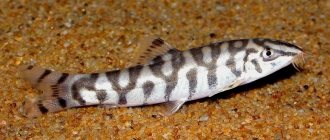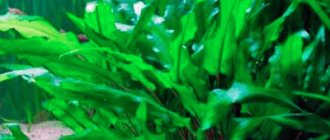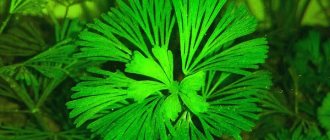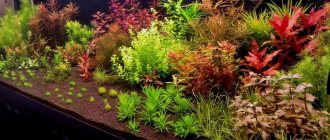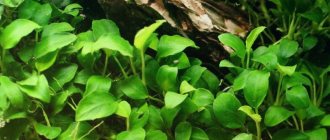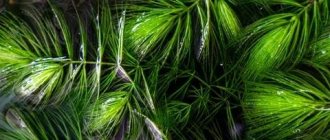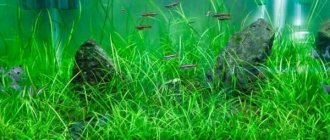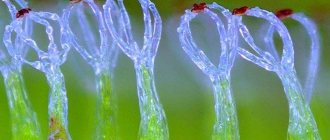Botanical description and natural habitat
Belongs to the Acanthus family, genus Flowering Dicotyledons. There are about 100 varieties of Hygrophila, which differ from each other in the color and shape of the leaves, as well as the size of the bushes. The homeland of this plant is considered to be Southeast Asia, where a humid tropical climate prevails. Moreover, it can grow both on land and in water, being essentially an amphibian. Prefers bodies of water with a slow flow (small rivers, channels) or without it (wetlands, for example, lakes and ponds). Favorite location: shallow water with plenty of sun, avoids shady areas. The optimal temperature range for growth is from +18…+30 °C. Loves nutritious soil.
Photo gallery Hygrophila:
Outwardly it looks like bushes with small, long, elongated leaves arranged in pairs. The color in natural conditions is rich green on top, and silver on the back. They can reach 20 cm in length and about 2 cm in width. Under optimal conditions, the plant can grow up to 20-30 cm in height, and up to 15 cm to the sides.
It propagates vegetatively, that is, by parts of the stem or leaves. Due to the almost continuous cycle of rebirth, the exact lifespan is impossible to determine.
Appearance
| Kingdom | Plants |
| Department | Flowering |
| Class | Dicotyledons |
| Squad | Multi-feathered |
| Family | Acanthus |
| Genus | Hygrophila |
The average bush of the plant reaches a height of 30 to 50 cm, and grows up to 15 cm in width. This aquatic plant has light green or dark thin leaves that extend from long stems. The stem is darker than the leaves. The length of the foliage ranges from 6 to 15 cm. Willow leaf received its name due to the similarity of the leaves to willow. In rare cases, hygrophila may bloom; white inflorescences can be found in the leaves that are located above the water.
Description
Hygrophila belongs to the genus of dicotyledonous flowering plants of the Acanthaceae family. Hygrophila has more than 27 varieties. The Acanthus family includes more than 200 species of plants, both aquatic and land.
Kinds
There are many types of hygrophila , let's consider the most popular among aquarists:
Hygrophila polyspermous.
It is distinguished by oval-shaped leaves with rounded ends. More demanding in terms of care and water parameters. Hygrophila loosestrife or lacustrine . View in question. Schisandra . It is distinguished by openwork dense leaves of light green color . The inflorescences have a bluish tint. Patterned . It is distinguished by light pink foliage with white veins . Biologists suggest that this color was the result of a virus that changed the proper production of chlorophyll.
Habitat in nature
The homeland of hygrophila is the coast of Southeast Asia. It is most common in swampy bodies of water with slow currents or in stagnant water in ponds and lakes. Most often it is located closer to the surface at shallow depths.
Benefits for the aquarium
Hygrophila has the property of purifying and filtering water in an aquarium, and cleanses the reservoir of nitrates. It is easy for fish to lay eggs on the strong leaves of this plant.
Mr. Tail recommends: varieties
A large number of varieties have now been bred for keeping in aquarium conditions. Among the most popular are the following.
Polyspermous marbled Hygrophila
Most popular among aquarists with little experience. The leaves are oval in shape, reach 6 cm in length and 3 cm in width. They are colored light green in water and red-burgundy in air. Thanks to the veins of white, orange, red, yellow, it produces an unusual pattern, for which it is valued. The stem is elongated. The bushes grow up to 40 cm in height and 10 cm in circumference.
Feels good in any aquarium, regardless of its size. With sufficiently intense lighting, the species tends to turn red foliage. For this variety, it is preferable to use fairly fine soil; the diameter of the grains of sand should be no more than 3-4 mm. With prolonged (at least 10 hours) and intense lighting it grows more abundantly.
If there is a lack of light, it begins to stretch in length and the size and number of leaves decreases, which spoils the appearance of the plant.
Hygrophila varifolia or sinema
This is a very popular variety among aquarists. It has a fairly long stem, the shape of the leaves varies depending on the light intensity. They can be oval or large-cut. It is unpretentious to living conditions and can grow in an aquarium of any size. Usually planted in the center, as it is very beautiful and will be a highlight.
Prefers warm water from +24...+26 °C, but can easily withstand temperatures down to +20 °C. Under cool conditions, it begins to grow more slowly.
If the lighting is natural or moderate artificial, small oval sheets form on Hygrophile; when the light intensity increases, they increase in size and become carved, openwork, patterned.
Another unusual feature of this species of Hygrophila is that it can either simply float in water or take root in the soil. With both types of accommodation he feels equally good. For planting in the ground, you should give preference to a mixture of sand with small pebbles with the addition of peat and clay, but it also grows quietly in larger masses. The thickness of the soil layer does not have strict parameters; any will do.
It propagates, like other varieties, by cuttings; you can also leave a torn leaf floating in the water and after a while roots will appear on it. After this, it can be planted in the ground.
This Hygrophil species grows well in greenhouses with high air humidity. It is enough to transplant the aquatic plant with its roots into nutritious soil and ensure timely watering and spraying of the leaves.
Willow Hygrophila or longifolia
The largest representative of the family, it grows up to 40 cm long. It has long leaves (about 12 cm) of light green color with a smooth or jagged edge, similar to willow, which is how it got its name. Moreover, the upper surface is slightly darker than the back.
If part of the plant peeks out of the water, small white flowers may appear located in the axils between the leaves.
Does well in taller aquariums as it tends to grow in length. Plant on the sides and at the back wall.
Loves intense lighting; lamps must have a power of at least 0.5 W per 1 liter of water and long daylight hours (about 10-12 hours). Under these conditions, the leaves take on a brown tint, and the middle vein remains green, which makes the plant unusual and expressive.
It is unpretentious to living conditions, but feels best in tropical aquariums with an ambient temperature of +22...+26 °C. It is important to choose the right soil; it must be sufficiently nutritious, because Hygrophila has a developed root system. To do this, mix a little peat and clay into the substrate (sand or small pebbles).
Hygrophila aguaia
It is classified as short, but very beautiful. The most demanding in terms of growing conditions, compared to other varieties. In its natural habitat it prefers to settle in the shallow waters of Brazilian and Japanese rivers. It was first discovered and described in 2006, but has already gained popularity among aquarists, both amateurs and professionals.
Hygrophila reddish
The rarest representative among aquarium varieties. The plant has a long stem with long and narrow leaves, colored brownish-red or pinkish. They are about 8 cm long and 0.5 cm wide.
Due to the ability of Hygrophila Russet to grow in height, it is worth placing it near the side and back walls of the aquarium. It is important to organize a long day of light (about 10-12 hours) with good intensity (0.4 W per 1 liter of water).
The temperature regime prefers around +24 °C; in colder environments, the color begins to fade, the lower leaves fall off, the trunk becomes thinner and elongated, causing it to lose its attractiveness.
Hygrophila pinnatifida
This is a very beautiful and unusual plant, loved by many aquarists. It grows quite slowly, but this is more of an advantage than a disadvantage. It can reach from 15 to 30 cm in length. The color of the foliage is variable and depends on the intensity and duration of lighting. It can be either green or reddish-burgundy with pink. The roots are extremely poorly developed, so nutritional value and soil fraction are not so important for it. It can even be attached to large bottom stones and snags.
It feels most comfortable in water +23…+26 °C and at a pH of 5.5-7.5.
If an aquarist wants to maintain a compact shape, then you need to monitor the lighting intensity (the lamp must be at least 5 W per 1 liter of container) and promptly remove side shoots. Looks best in compositions in the middle, next to taller species.
Hygrophila Schisandra Carimbosa
This species is also called Normophila straight or Thyroid. It has a long and strong stem with oval elongated leaves with a sharp tip. Painted light green on the top surface and silver on the back.
Looks best when planted along the sides and back walls of the aquarium.
It prefers water temperatures from +24...+27 °C, and grows more slowly in colder waters. The hardness should be about 8°; if it is less (softer), the sheets will become brittle and begin to collapse, thereby exposing the stem. It is necessary to change 1/3 of the water every 7 days.
Loves intense lighting and long daylight hours (at least 10 hours). If this condition is not met, the plant begins to feel unwell, which leads to the destruction of the foliage and a deterioration in the appearance for which it is so valued.
The soil should be nutritious and at least 5, and preferably 7 cm thick, because its roots are well developed.
Hygrophila siamese
Thailand is considered its homeland. Outwardly similar to lemongrass, but the leaves sometimes acquire a bluish and lilac tint. The roots are well developed, which requires a nutrient substrate in the soil and its thickness of 5-7 cm. When the plant rises above the water level, small blue flowers appear on the protruding parts.
This species is extremely unpretentious to the parameters of the aquatic environment, and therefore can be planted even by novice aquarium lovers. Grows at temperatures from +22...+28 °C, hardness 4-14° and pH from 5.5 to 8.
To ensure that the plant bushes and does not stretch upward, the tops are pinched, then numerous side shoots appear.
Growing and care
The plant grows well in tall aquariums. Although it is not classified as difficult to care for, there are still a number of recommendations for growing:
- Can be used to create bottom support during spawning. This measure protects the eggs from being eaten by fish.
- If the crop is not under water, it should be protected from direct sunlight.
- In intense overhead lighting, hygrophiles act as a natural light filter that reduces the risk of water blooms.
- It is desirable that the long stems of the plant are hidden under water. When above water it demonstrates its best decorative qualities. The cut fragment can be used as fertilizer for indoor crops.
- When pruning, it is important to control the cut line; it should be higher than the previous one.
- Plants grown in a nursery often have difficulty adapting to new conditions.
The graceful elongated foliage of Hygrophila loosestrife looks good in large aquariums in the vicinity of broad-leaved or round-leaved crops.
It is equally beneficial to place plants in separate groups in the center. The decorative qualities are enhanced in herbals with a gentle current, which highlights its beautiful wavy foliage.
Optimal water parameters
The plant quickly adapts to new conditions and can easily tolerate temperature drops below 20°C and above 26°C.
Recommended settings:
- temperature - 20-26°C;
- hardness - 8-10° dH;
- pH - 7-8;
- NO3 - 10-15ppm;
- PO4 - 0.5-1ppm.
A weekly water change of 25% of the total volume is required. Also, don't forget about filtering.
Lighting requirements
- Intense lighting of 70-100 Lm/l for up to 12 hours is preferable, calculating 0.5 W per 1 liter of water. When exposed to bright light, the leaf blades acquire an interesting brown or bright red hue. Despite the love of these aquatic beauties for light, they calmly tolerate long-term shading. But with a lack of lighting, the leaves become smaller and the stem becomes elongated.
Soil requirements
- Despite the fact that this plant can be grown without soil, fixed, for example, on driftwood, it is advisable to take care of the quality of the soil. This is necessary to create comfortable conditions for other aquarium crops. The nutrient base can be formed from coarse river sand with a fraction of 4 mm, medium-grained sand with a fraction of 2 mm and fine gravel. The recommended thickness of the 1st layer is 2 cm, the 2nd layer is 4 cm, the 3rd layer is 2 cm.
The need for feeding
Hygrophila loosestrife receives all the necessary nutrients from water.
To give the plant an aesthetic appearance, it is advisable to regularly feed it with liquid fertilizer.
You can use industrial mixtures. They are well balanced in composition, which eliminates the need to independently calculate the concentrations of nutrients.
Tropica Premium Nutrition fertilizer is popular among aquarists. It does not contain phosphorus and nitrogen and is enriched with manganese and iron. It is enough to add 6 ml per 50 liters of water once a week.
Aquarium Basics
Like any plant, Hygrophila has its own maintenance characteristics and requirements for water parameters. It is important to pay attention to the following.
Priming
It should be fine, silty, small fractions of sand or pebbles, with a diameter of about 3-4 mm, work well. There are also increased requirements for its nutritional value, since Hygrophila has a developed root system. To do this, clay and peat are added to the substrate in small quantities. The soil is poured onto the bottom with a thickness of 4-6 cm. This is most optimal for the plant.
Requirements for water parameters
If they are followed, the plant will grow well and delight with its appearance. These include:
- Temperature. Should fluctuate between +20…+26 °C.
- Hardness from 3 to 15 °. In harder water, the stem becomes thin and brittle, and the leaves become thinner.
- Acidity is most optimal in the range of 6.5-7.5 pH.
- A weekly change of 30% of the water to settled water is required.
- Careful filtration is required. Any medium power device will do.
- It is unpretentious to aeration, but you should not run the aquarium too much, otherwise the leaves will begin to die and thin out, which will affect the appearance of the plant.
Aquarium dimensions
They depend on how many Hygrophila bushes and what varieties the aquarist is going to plant. On average, the width of each plant reaches about 15 cm, and the optimal distance between them should be 5-10 cm. This will ensure quiet growth and protect against intertwining of root systems, which can negatively affect the growth and beauty of Hygrophila.
Lighting
It can be: natural, artificial, but the most optimally combined. At the same time, it is worth protecting Hygrophila from direct sunlight, as it can cause burns and yellowing of the sheets.
Lamps (preferably fluorescent) with medium or low power are suitable, that is, they are purchased at the rate of 0.5 to 0.6 W per 1 liter of water. It is important not to forget about the duration of daylight hours; it should be 10-12 hours.
Content
Since Hygrophila corymbosa loosestrife forms a fairly powerful root system, it needs a layer of fine soil of at least 3-5 cm. A nutrient substrate is not necessary - if there is a lack of nutrients, the plant forms additional roots along the powerful stem to obtain nutrients from water.
Strong lighting is not required for plant growth; the intensity can be moderate to strong.
Adding CO2 to the aquarium is not necessary, but carbon dioxide will promote faster and healthier growth. Hygrophila loosestrife grows quite quickly in medium light without CO2, but in strong light additional nutrition is recommended.
Also, in strong lighting, the plant needs additional macro fertilizers (nitrates, phosphates, potassium).
Hygrophila loosestrife can become a kind of living indicator of the well-being of the environment for aquatic aquarium plants. If small holes form on its older leaves, this is a signal of potassium deficiency. Premature yellowing and death of old leaves indicates a lack of nitrates. New white leaves are a sign of iron deficiency.
In general, as long as you meet the plant's minimum needs and create a gentle flow in the tank so that the water flows through the hygrophila to bring nutrients, you will achieve the growth of graceful, wavy, attractive foliage.
Diseases and pests
If the rules for caring for Hygrophila are violated, it grows greatly and protrudes above the water level. Therefore, it is important to monitor its length and trim overgrown bushes in time. When outside the aquatic environment, the sheets can get burned and turn yellow; in this case, reduce the intensity of artificial lighting and remove them from direct sunlight (in natural conditions).
When the bush weakens, the stem becomes brittle and the foliage turns pale, you should pay attention to the parameters of the aquatic environment and normalize them. After this, she will return to her original beauty.
Hygrophila is a very beautiful and unusual plant, which, with proper care and maintenance, will delight you with its appearance for many years.
